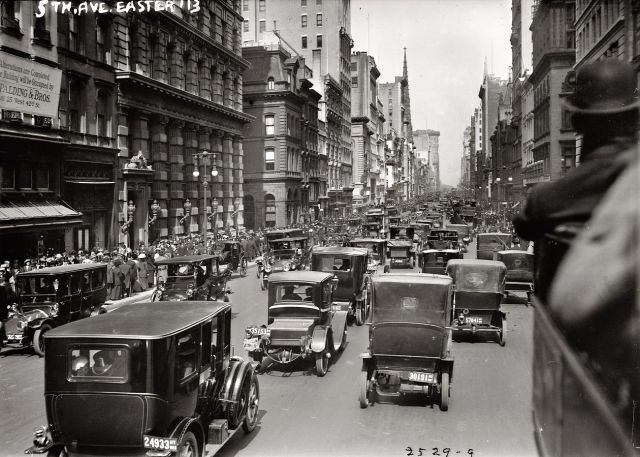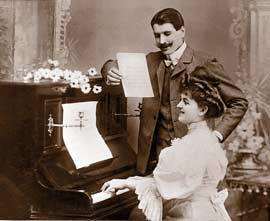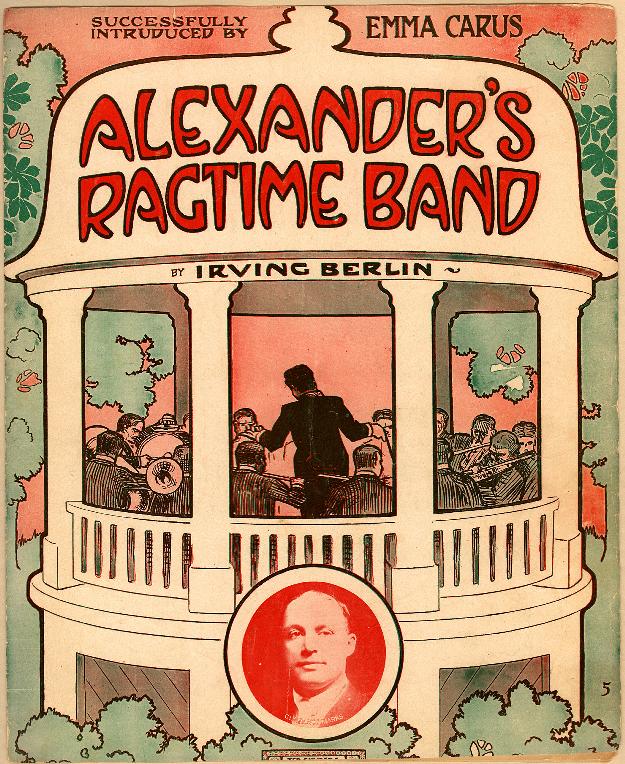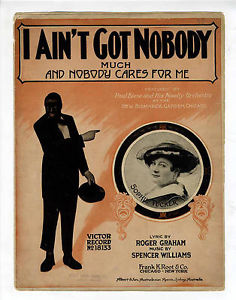Note: This edition of Riverwalk Jazz was recorded live at Dinkelspiel Auditorium on the campus of Stanford University in the summer of 1999. At a time when the nation was obsessed with speculation over the potential hazards (Y2K) and benefits (unknown) of life in the new millennium, Riverwalk Jazz takes a look back at the turn of the 20th century.

New York's bustling Fifth Avenue, 1915. Photo in public domain.
The last time Americans faced the turning of a century, some things were very much like they are now. New technologies were speeding up life to a breathless pace. From automobiles to X-rays, new inventions like the telephone and gramophone were changing the way people lived. New ideas from thinkers like Albert Einstein and Sigmund Freud changed the way people thought about themselves and the world they lived in.
New sounds of music filled the air. Ragtime tunes, Blues, Cakewalks and slangy popular songs began to edge out parlor songs, operettas and waltzes. There was a new kind of President in the White House. Teddy Roosevelt charmed the country with his rough-hewn style. Roosevelt was no buttoned-down bureaucrat. He was an outdoorsman, an explorer and self-styled “Rough Rider.” His outspoken pride in everything American helped the country take notice of its homegrown music. Roosevelt’s bigger than life personality was in tune with the ragtime beat of the new syncopated music that had toes tapping and fingers snapping.

Early 1900 parlour scene. Image in public domain.
This week we take a look at popular music from this transitional era in American music—before jazz took over the main stage and stole the show in the 1920s. All the tunes heard here were written between 1895 and 1916, as pop music was first beginning to have a truly American sound. We’ll hear The Jim Cullum Jazz Band’s jazz interpretations and improvisations on ‘turn of the century’ parlor songs, waltzes, rags and blues. This broadcast was recorded live at the renowned Stanford Jazz Workshop in California where the Cullum Band members taught master classes and gave private lessons.
In the early 1900s many popular songs of the day were simple waltzes or sweet and sentimental songs. The home entertainment center for many was an upright piano in the parlor where family members gathered around to sing along or play their mandolins, autoharps or guitars. Jim Cullum says, “This is how it sounded before jazz began to raise its head on the scene.”

Sheet music image courtesy of Duke University Libraries.
Notes about the music on this broadcast:
In 1911 Irving Berlin’s first big hit, a peppy, syncopated number called “Alexander's Ragtime Band,” swept the nation. About the same time, the blues was introduced to mainstream audiences in a form they could accept and appreciate. Bandleader W.C. Handy published his “Memphis Blues” in 1912 and for the first time people could buy sheet music of the blues in dime stores and department stores everywhere in the land. In 1914 Handy wrote his famous “St. Louis Blues” and “Yellow Dog Blues,“ the latter heard here.
Songwriter and music publisher Spencer Williams was born in 1889 in New Orleans and was orphaned early in his life. His aunt, Lulu White—the most notorious of all New Orleans prostitutes and “madams”, took him in and raised him as her own. White ran a glamorous brothel on Basin Street called Mahogany Hall. There, young Spencer got his musical training from piano players who ‘tickled the ivories,’ providing entertainment at Mahogany Hall and other saloons in the district. Here, The Jim Cullum Jazz Band performs one of Spencer Williams’ first compositions, “Tishomingo Blues.”

Spencer Williams sheet music image in public domain.
In 1916, Williams’ piece “I Ain't Got Nobody“ sold a great deal of sheet music and gave him a major hit. Vaudeville stars such as Sophie Tucker covered it and it became a perennial standard for pop performers over the decades. Today, “I Ain’t Got Nobody” remains a popular jam piece for countless jazz bands and is performed here by The Jim Cullum Jazz Band. Spencer Williams went on to write many venerable jazz standards including his “Basin Street Blues,” homage to his origin.
As America was about to enter World War I in 1916, a sentimental ballad “Poor Butterfly,“ inspired by the Puccini opera Madame Butterfly, became all the rage. It’s been a popular choice for jazz artists through the years and has been recorded by numerous musicians and vocalists from the classic period: Red Nichols, Andy Kirk, Benny Goodman, Art Tatum and Sarah Vaughan and many more. Our rendition features Ron Hockett on clarinet.
1916 also produced “Pretty Baby“ by ragtime pianist Tony Jackson. Here, pianist John Sheridan demonstrates Jackson’s original ragtime concept of the tune, followed by a hot jazz version by Jim and the Band.
The Tin Pan Alley tune “Take Me Out To the Ballgame“ hit a home run in 1908, when baseball was fast becoming the national pastime, and it was soon adopted as the unofficial anthem of the game by baseball fans everywhere.
.jpg)
Sheet music, 1908. Image courtesy of Library of Congress.
Today, more than any other tune, the 1895 parlor waltz “The Band Played On“ is identified with the bittersweet romance of the ‘Gaslight Era,’ 1890-1919.
“Hiawatha“ is an early New Orleans three-part march number. Jim Cullum says, “They say it was around in the late 1800s. Old-timers tell me that back then it was called “Lizard on a Rail.” The tune was copyrighted in 1901 as “Hiawatha Rag,” and songwriter Charlie Daniels, also known as Neil Moret, added the lyrics in 1903.
“Bill Bailey Won't You Please Come Home?“ by Hughie Cannon, dates from 1902. The tune has become a popular Dixieland standard, covered thousands of times since its debut. Joining The Jim Cullum Jazz Band on the vocal is Chuck Huggins, a great supporter of San Francisco Bay Area jazz and the Riverwalk Jazz public radio series.
Photo credit for Home Page: Sheet Music, 1908. Image courtesy American Treasures of the Library of Congress.
Text based on Riverwalk Jazz script by Margaret Moos Pick ©1999

